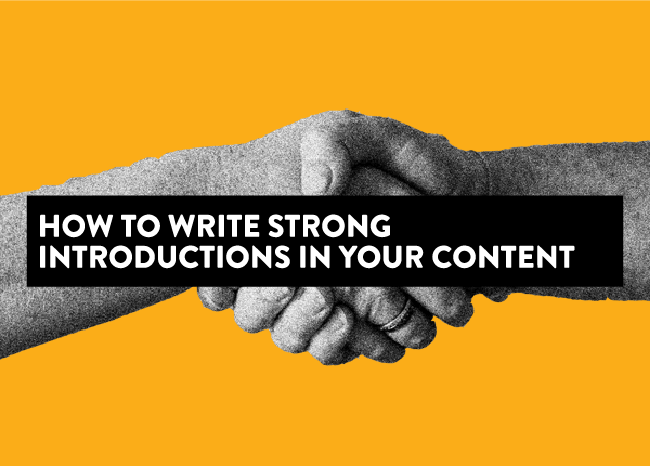

A strong introduction is critical to provide valuable information upfront, set the tone for an article, and allow the reader to understand what they can expect in the body of the article.
Setting the reader’s expectations for an article will give them an idea of the information to come and demonstrate the quality they can expect from the article. For example, by using a professional tone, offering useful data, and citing reputable sources upfront, you show the article’s credibility to readers and that it has been well-researched. Additionally, by answering important, fundamental questions early on, you signal that the content is accessible and will provide the information they need.
While virtually all good introductions involve basic components such as a hook, necessary context, and a thesis, it is important to not appear obviously formulaic, as it will make the language feel less natural. Largely, the ability to do this will come from practice and the acceptance of helpful feedback from editors and other professionals. Often, writers worry too much about the introduction, which could lead to indecision early on in the article. Remember that you can come back and polish the introduction as needed.
The Importance of an Introduction

The introduction serves many important functions in an article, notably as an attention grabber, a first impression, and a road map. In content marketing, an article’s introduction is particularly valuable, as it’s the first opportunity to demonstrate professionalism and answer the reader’s questions.
Establish Your Credibility
Introductions are the first opportunity to establish credibility with the reader. Establishing your credibility is important to instill trust and earn links from other websites. Ways that you can earn credibility:
- Include external links from reputable sources
- Use professional tone
- Answer basic questions about the topic
- Explain information quickly
- Include hard data like statistics or other research to support your claims.
It is important to maintain a balance of high-quality, professionally-delivered information and accessible, readable language.
Provide a Roadmap
The introduction should establish early what the reader can expect from your content. This does not mean literally listing everything that will be in the content. For example, instead of saying, “This article will discuss what to wear during an interview, what questions may be asked during an interview, and how to respond to interview questions professionally,” you could allude to these points. An example of this would be, “There are many steps you can take to improve the outcomes of your interviews with proper preparation.”
Improve SEO
Although an introduction should be built for people first, it can also serve as a valuable opportunity to strengthen keyword signals and optimize for search engines. The introduction should naturally include the target keywords, which help establish the article’s premise. It can also signal the reader that the article’s content matches the searcher’s intent.
Make Your Readers Want More
The ultimate goal of an introduction is to make your readers want to read further. This practice goes beyond simply getting their attention and involves demonstrating the article’s value to the reader. It also functions as a way to transition the reader smoothly into the article.
Elements of an Effective Introduction

An effective introduction has three major elements: a hook, important context, and a thesis. However, it can be challenging to include all of these elements while using natural language.
How To Hook the Reader
There are many tactics that you can use to hook the reader:
- Including answers to basic questions about the topic;
- Offering interesting facts and research;
- Providing a real-world example related to the topic.
This approach can be difficult to accomplish in the context of a professional piece of content built for SEO purposes, as it can be challenging to draw reader interest while using a professional tone. However, by thoroughly researching and understanding your topic, you can strive to create a hook that will encourage people to read further into your article.
By researching the topic, you can become familiar with any existing literature related to it and gain insight into key concepts and arguments often associated with it. This breakdown will help you create an opening paragraph that effectively introduces the main points of your article. Additionally, researching the topic may give you ideas for framing your article to make it more compelling and draw readers in.
How To Provide Context
You will need to provide important context early on. Important context to include:
- Information that illustrates challenges related to a topic, such as statistics on how many grapple with a particular type of difficulty;
- Demonstration of future opportunities, such as projections about the future of the job market;
- Definitional content that will help the reader better understand the discussion going forward.
This contextual information will often act as the bridge between the hook and the thesis.
How To State Your Thesis
A thesis is a simple statement that illustrates the content the reader can expect to find in the body of the article. It should be clear but not overly formulaic.
The thesis should also act as a transition into the main body of the article. An example of a thesis for an article about how to start a hiking hobby would be: “There are several important steps that you should complete before taking on hiking as a hobby.” Meanwhile, an example of a thesis for an article about finding career resources would be, “There are many opportunities at school, work, and your greater community to find valuable career resources.”
Tendencies To Avoid

You should try to avoid certain tendencies related to ineffective writing, such as:
- Passive voice
- Cliches
- Formulaic language
- Tone and word choice inappropriate for the topic and your brand
- Basic definitions that offer little information
- Ambiguous information
- Sloppy, unedited writing
For SEO content, it is vital to marry professionalism and facts with creativity in a way that makes the content interesting but not overly familiar.
Helpful Tips and Tricks
 The following tips and tricks can further help writers overcome writer’s block and develop their content:
The following tips and tricks can further help writers overcome writer’s block and develop their content:
- Consider writing the introduction last. After writing the body of the article, the main points will be fresher in your mind, and therefore you will be better equipped to provide important context and develop a roadmap.
- Keep the reader’s perspective in mind. Remember that the reader is coming to you to learn something, so it is important to not forget that and overlook vital information that they will need to understand the topic. Furthermore, it is essential to remember what type of language will be most accessible to the reader.
- Read your introduction and conclusion one after the other. This practice can allow you to more effectively assess whether you sufficiently addressed the information in the intro.
Writing an introduction can be difficult, especially when trying to incorporate all of these key elements with natural-sounding language. Review your introduction to assess its purpose and whether it sounds strange or robotic. Waiting for a while may give you a clearer perspective. Finally, remember that writing and editing skills will take time and practice.



